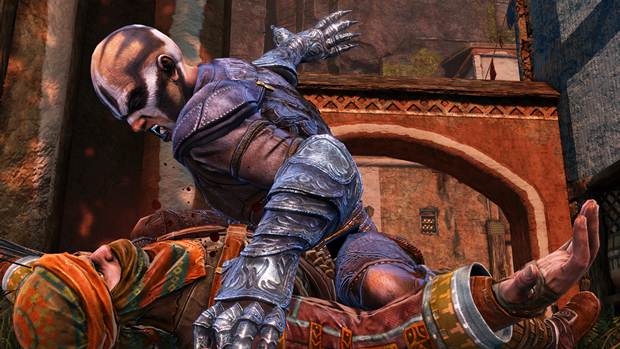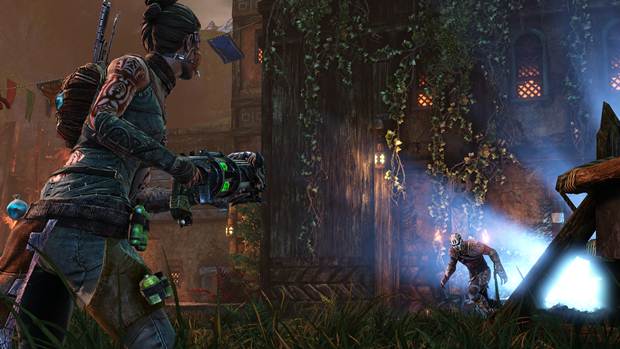
Ten years. That’s how long it’s been since the release of the last game in the Legacy of Kain series. Despite its critical and commercial success and enduring popularity, the series just never went anywhere after 2003’s Legacy of Kain: Defiance. Series creator Silicon Knights’ creative and financial issues are many and well-documented, and series curator and long-time developer Crystal Dynamics has spent the last few years working on the Tomb Raider franchise after losing Legacy of Kain writer and director Amy Henning to Naughty Dog.
In large part, it was the perfect storm, and Eidos seemed more than content to let the series rest in purgatory while they worked on better known franchises such as Deus Ex, Thief, Hitman, and Tomb Raider. Fans had reason to rejoice when Square Enix purchased Eidos and expressed interest in reviving all of the latter’s dormant brands, but little came of it where the Legacy of Kain franchise was concerned.
"Gameplay itself is standard four on four team deathmatch, but that’s not what makes the title special. What does make it special are the differences between the two factions."
At least, not until recently, when Square Enix registered a number of trademarks and domain names that made reference to the series, and there were a number of leaks that hinted that a new Legacy of Kain title could be in development. While many fans were no doubt excited, it’s fair to say that few were expecting the next title in the franchise to resemble a game like Nosgoth.
Unlike previous entries in the series, Nosgoth is not a single-player game. Instead, it is a free-to-play multiplayer title. Developer Psyonix has likened the title to a MOBA, but such terminology will likely have most picturing games like League of Legends and DOTA 2, and Nosgoth is simply not that type of game. Frankly, Nosgoth doesn’t fit into any one category, and the game is all the better for it.
The game pits humans against vampires. Gameplay itself is standard four on four team deathmatch, but that’s not what makes the title special. What does make it special are the differences between the two factions. Humans are smaller and relatively weak up close, relying on bows, crossbows, and grenade launcher-esque weapons, as well as flash grenades, fire bombs, and other tools of the trade to take the vampires out at range. The vampires, on the other hand, are close range monsters with the ability to fly, barrel through entire teams, and pounce upon unsuspecting humans. The game is played from a third person viewpoint, and alternates between the two styles quite easily. As a human, you’ll feel like you’re playing a third person shooter. As a vampire, you’re in the middle of a hack n’ slash.
"The Alchemist, however, is the most interesting. She carries a hand cannon that fires explosive concoctions, can drop a line of fire on the ground for quick escapes, and blind her enemies with flash grenades."
Classes add another layer of depth to the proceedings, and the vampires are easily the more varied of the two factions. As a Tyrant, you’ll be able to barrel through human enemies and send them flying, pound the ground and briefly stun your opponents, and protect yourself with a short burst of armor that prevents you from attacking. Choosing a Sentinel will allow you to fly, create powerful gusts of air with your wings, pick up your enemies and drop them from great heights, and dive onto unsuspecting humans. The quick and agile Reaver is at his best when he’s lurking in the shadows and pouncing on his enemies, dealing huge damage before he escapes through a haze of poisoned smoke at great speed, dodging everything you shoot at him.
That’s not to say that the humans are unprepared, however. The Hunter has access to crossbows, incendiary arrows, and a bola, which can incapacitate foes for a brief period of time. The Scout specializes in hit and run tactics, and can charge shots from his bow for more damage, use throwing knives, and call down a hail of arrows. The Alchemist, however, is the most interesting. She carries a hand cannon that fires explosive concoctions, can drop a line of fire on the ground for quick escapes, and blind her enemies with flash grenades.
The differences between each class makes each match exciting, and you’ll have to use each one, and work with your team if you hope to win, especially since you’ll have to play as both factions to win a match. The team with the best overall score wins, so you can play poorly in one round and still have a chance in the next. As such, mastering your classes is essential to victory, but you’ll have to learn the differences between the races, too. Vampires have the ability to scale walls, giving them access to more of the map, while humans can sprint, which makes it easier to get out of tight corners. Even health is handled differently. Both sides regenerate health after they’ve spent some time out of combat, but neither fully recovers on their own. Vampires will have to seek the corpses of defeated foes and drink their blood if they hope to stay healthy, while humans must make use of various caches scattered around the levels, which can also be used to restore ammunition.
"The game is surprisingly well-balanced given the differences between the factions, and matches are often decided by one good engagement. The graphics and sound are equally impressive, and little things, from the armor on the characters to the way they taunt one another after a kill, go a long way toward selling the setting."
Maps themselves are well designed, if a little samey, and offer a lot of verticality, so you can approach a situation from a variety of angles in any given encounter, especially as a vampire. On the flip side, humans have enough room to move as a team, and easy access to health and ammo reserves, though there’s never enough available to cause an imbalance. As such, gams are usually an intense game of cat and mouse. Humans will stick together, hoping to win the day through range and superior firepower, while vampires stalk the shadows looking for an opening, or if you’re a Tyrant, the opportunity to make one.
The game is surprisingly well-balanced given the differences between the factions, and matches are often decided by one good engagement. The graphics and sound are equally impressive, and little things, from the armor on the characters to the way they taunt one another after a kill, go a long way toward selling the setting.
Doing well in-game unlocks gold for the shop. Here, you’ll be able to buy new weapons, perks, and abilities, such as a leaping attack for your Tyrant or a flamethrower for your Alchemist. There are also experience boosters and vanity items for sale, and while all of this will require serious farming or real-world cash to unlock permanently (you can also rent items for a week for a fraction of their purchase price), none of it seems unbalanced, especially since most upgrades are marginal, and can only be equipped in certain slots.
While the game still has minor technical problems, I’m impressed by what Psyonix has been able to do here, and how fun it is so far before release. Perhaps fittingly, one of my teammates summed up my thoughts very well as we were waiting on players for our next match. “Man,” he said, “this game is fun.” And indeed it is. It may not be the Legacy of Kain game many were hoping for, but if its alpha is anything to go by, it may be the one we need.

















